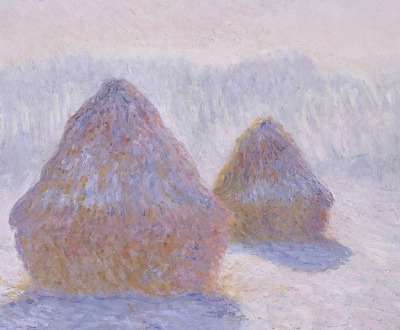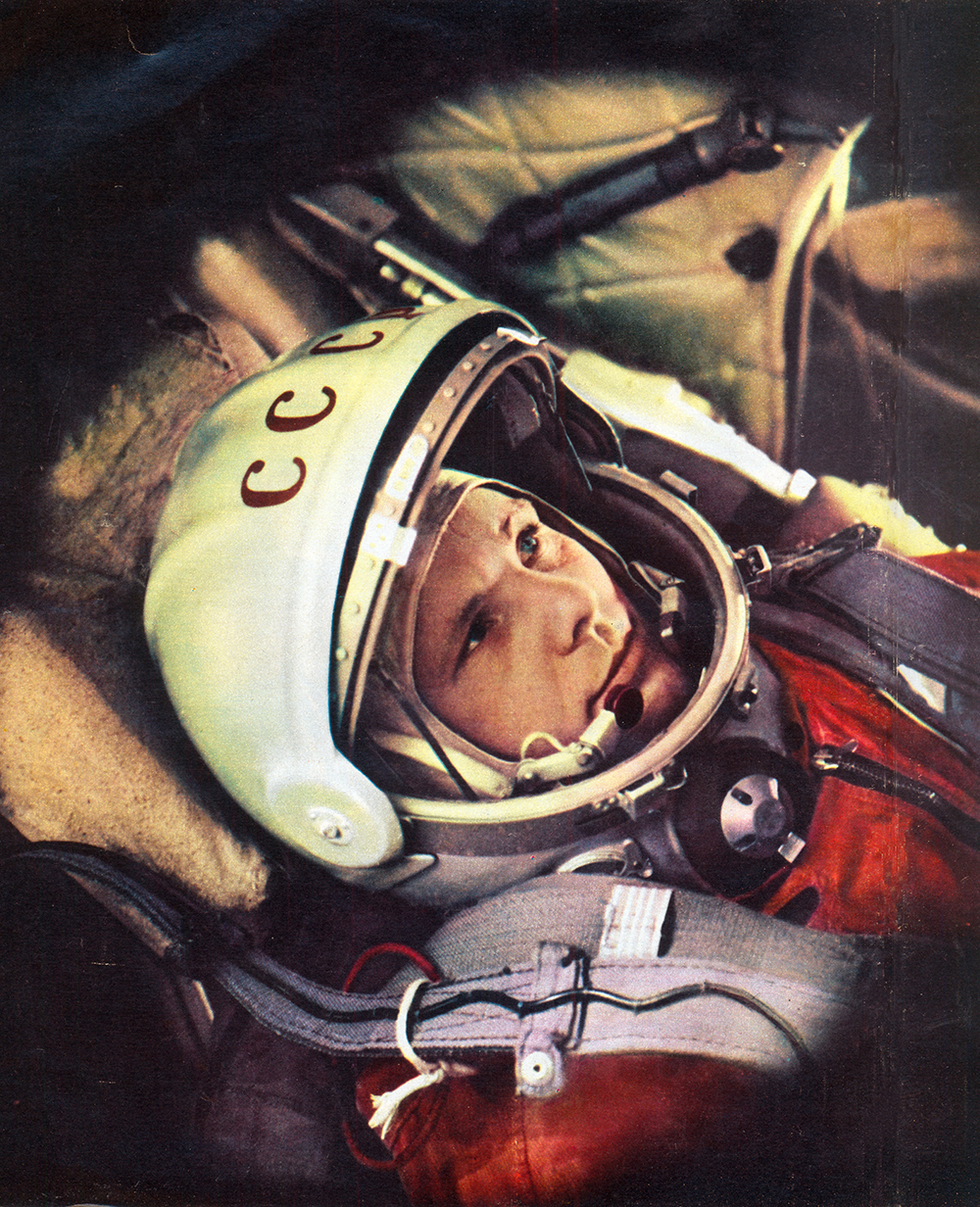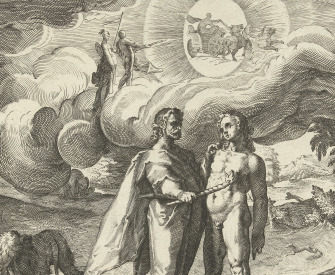How gloriously legible are the constellations of the heavens!
—Anthony Trollope, 1859
Haystacks (Effect of Snow and Sun), by Claude Monet, 1891. © The Metropolitan Museum of Art, H.O. Havemeyer Collection, Bequest of Mrs. H.O. Havemeyer, 1929.
Step 1
One winter morning a few years ago, in order to fill a void in our vacation plans, four friends and I went for a drive across the Canadian tundra looking for wild bison. On the map, the Mackenzie Bison Sanctuary looked close to our hotel in Yellowknife, but distances are deceiving amid such vast expanses—in reality, the preserve was more than 150 miles away. We drove for most of the day. The frost-patched road was very long and very straight but oddly undulate; our Jeep rose and fell like a ship passing over gentle waves. Lulled into a hypnotic stupor, we drove south, and south, and south, promising ourselves that we would turn around at the next rise, but then, reaching it, driving a little farther, rising and falling, through an unremittingly monotonous landscape. On the snowy roadside ran two-lane bison trails, which I at first mistook for snowmobile tracks. The trails intermittently snarled up, marking places where the bison had apparently paused to stomp around in circles. Here and there lay piles of their scat. But the bison themselves eluded us.
Our view of the surrounding land was often blocked by stands of evergreens, which lined the roadside like ragged gray sentries. Glancing through breaks in the trees, we could occasionally glimpse glowing white expanses, hidden realms. Our map indicated these were frozen lakes. Somewhere near the edge of the preserve, we stopped at one such lake and got out of the car. The air, at around −20 degrees, felt like a frozen windowpane pressed against a warm cheek: stinging, windless, and clear. Trudging through the dry, glittery snow, sinking to our shins, we passed through the trees and stepped out onto the open lake. I had hoped to see a herd of bison there, dark and distant, but instead all we found was about two hundred yards of pristine, perfectly level snow, as smooth as a freshly tucked sheet. I felt a flicker of Wallace Stevens’ wintry emptiness, that sense of “nothing that is not there and the nothing that is.”
The polar explorers of the early twentieth century knew this feeling well. While leading his expedition party to the South Pole in 1911, Roald Amundsen wrote that “it is damnably unpleasant” to “stare at nothing.” The dogs also apparently hated the sight of it; Amundsen’s rival, Robert Falcon Scott, found that his dog team refused to push forward into the white void without a person in front of them to provide a visual reference point.
An essay published in Boys’ Life magazine in February 1912, the month after Scott finally reached the pole, instructs interested young readers how to photograph snow properly. “It is, of course, seriously objectionable,” opines the author, “to have a pure, lifeless white field of snow, unbroken by footprints or shrubbery or an object of some kind.” I’m suspicious of this reasoning, if not its conclusion. Lifelessness is not the issue. We moderns, inheritors of a Romantic gaze, can find beauty in even the most stark and inert landscapes: a sandstone canyon and a snowcapped mountaintop are barren in their ways, but they can nonetheless inspire great awe. I believe we all recoil at a flat white field for a different reason: because it is blank.
This peculiar horror vacui has been felt by almost every person at some point: by the author staring at a blank page, by the artist staring at a white canvas, by the adolescent staring at a bedroom ceiling while contemplating an unknown future. In some sense it is a mark of maturity. When we are very young, blankness can still inspire and excite: I recall, in kindergarten, the distinct pleasure of taking out a new, immaculate page of drawing paper, gleaming with the promise of freedom, possibility, and experimentation. Pouring over maps as “a little chap,” Marlow (the narrator of Joseph Conrad’s Heart of Darkness) found delight in places like the North Pole, which were unexplored, uncharted, unclaimed by empire. They presented “a blank space of delightful mystery—a white patch for a boy to dream gloriously over.” The horror comes only later in life, as we learn the abundance of misery blankness can hold: the regret of setting out on the wrong path, the squandered time, the crippling indecision—and, in the case of the polar explorers, bodily suffering, permanent injury, and sometimes death.
If I had wanted to cross the frozen lake that day, what would have been the optimal method? I could have cut a straight line to minimize the distance; that would seem to be the most efficient course. But it requires enormous effort to maintain a straight line. Amundsen learned as much in Antarctica; he wrote that his party’s forerunners, pushing forward over blank terrain, continually tacked back and forth, overcorrecting for their errors, until the expedition members behind them began to accuse them of playing a prank. So maybe to minimize my overall effort, I should have meandered a bit, like water.
Or, thinking more radically, perhaps I should move beyond the narrow-minded mechanistic parameters of minimizing at all. For practical reasons, geographic explorers must always calculate their route based on expediency. But what about for artists or other aesthetes, who value beauty and novelty over mere efficiency? Once those new variables are introduced, one’s options multiply fantastically. I could attempt to walk a line of loopy, calligraphic elegance; I could even write a word in the snow with my footsteps. Perhaps the most aesthetically daring gesture would have been for me to take the maximalist approach: walking from side to side, as if reaping a field of wheat, row by row, covering the greatest possible area of ground. In all likelihood, no one in all of human history had ever walked across that patch of earth in such a counterintuitive way. There is an obvious satisfaction to finding new ground on the same old land. But is it too clever, too tiresome? Would anyone else follow in your footsteps?
This sense of anxious bewilderment attends the birth of any artistic exploration. The maximalist writer David Foster Wallace grappled with it throughout his life. He once noted:
Writing-wise, fiction is scarier, but nonfiction is harder—because nonfiction’s based in reality, and today’s felt reality is overwhelmingly, circuit-blowingly huge and complex. Whereas fiction comes out of nothing. Actually, so wait: the truth is that both genres are scary; both feel like they’re executed on tightropes, over abysses—it’s the abysses that are different. Fiction’s abyss is silence, nada. Whereas nonfiction’s abyss is Total Noise, the seething static of every particular thing and experience, and one’s total freedom of infinite choice about what to choose to attend to and represent and connect, and how, and why, etc.
These twin abysses are familiar to those of us who work in any realm of knowledge creation—not just literature but also science, history, philosophy, art, folklore, music, technology, mathematics. Wallace’s metaphor of walking a tightrope across an abyss works because it captures the attendant sense of vertigo and danger, but it is ultimately too narrow—it does not allow the writer to choose a trajectory, and so to feel the terror of choosing.
The more accurate analogy, I realized that winter’s day, was one that humans have been staring at and mulling over for millennia. The creative abyss is a snowy field. Not an abyss you tiptoe above but the one you must navigate. It is at once an infinity and a vacuum, total noise and total silence, everything and nothing. Your foot hovers; your head swims. To take even a single step into blankness is to enter a maze with boundless options and no clues.
Step 2
The Russian poet Varlam Shalamov recounts in Kolyma Tales, his memoir of the seventeen years he spent living in a Siberian forced-labor camp, that in order to escape working in the mines, convicts in the gulag would often use nitroglycerin capsules to blow off their own hands. The camp authorities would assign these maimed men to walking duty, where they would be “forced to spend the entire working day in deep, loose, crystal snow, tramping down a path for people and tractors at the timber-clearing sites.” (This work was so exhausting, Shalamov recalls, that some convicts blew off their feet, too.)
“How is a road beaten down through the virgin snow?” Shalamov asks. The answer:
One person walks ahead, sweating, swearing, and barely moving his feet. He keeps getting stuck in the loose, deep snow. He goes far ahead, marking his path with uneven black pits. When he tires, he lies down on the snow, lights a homemade cigarette, and the tobacco smoke hangs suspended above the white, gleaming snow like a blue cloud. The man moves on, but the cloud remains hovering above the spot where he rested, for the air is motionless. Roads are always beaten down on days like these—so that the wind won’t sweep away this labor of man. The man himself selects points in the snow’s infinity to orient himself—a cliff, a tall tree. He steers his body through the snow in the same fashion that a helmsman steers a riverboat from one cape to another.
“Life,” goes a Russian proverb, “is not a walk across a field.” But perhaps it would be more true to say: Life is a walk across a field of fresh snow.
Step 3
In the years before the Maoist invasion of Tibet, two Lamaist monks would gather near the base of Dakpa Sheri, the “Pure Crystal Mountain,” in the first days of spring. One lama was called the Snow Cutter, the other was called the Snow Firmer. Their job was to open a route around the mountain for the approaching pilgrimage season, when a great many Buddhists would circle holy mountains to purify their karma and improve the circumstances of their rebirth. Of all Tibet’s holy mountains, Dakpa Sheri was believed by many to possess the greatest spiritual power; a single circuit was said to multiply one’s karmic merit by many hundred million times, and seven days of meditation on its slopes were thought to be more effective than months or even years spent meditating elsewhere. So powerful was the mountain that even the animals grazing on its slopes would be reborn as gods.

Vanitas Still Life, by Edwaert Collier, 1662. The Metropolitan Museum of Art, Purchase, 1871.
But however enlightening it may have been, Dakpa Sheri remained a fearsome place. Like all the great mountains of Tibet, it was thought to be the home of powerful deities who would punish trespassers by sending down thundering avalanches. So “opening the mountain” (as this process was called) was a dual task: the lamas needed both to clear a walking path and to calm the wrath of the mountain spirits. As they walked, the lamas chanted and made offerings of cakes to the local gods. To avoid soft snow, they walked at night, holding torches. With them traveled a team of twenty strong young men, brought along to break through the snow crust. The lamas spurred them on with shouts of “Cut through the snow!” and “Each of you dig!” while the team passed by a series of landmarks with names that were by turns beatific and ghastly: Human Skin Ravine, Blazing Light Plateau, Turquoise Lake Palace, Community of One Hundred Thousand Sky-goers, Swine Flesh Pass. Of the tens of thousands of pilgrims who flocked to Dakpa Sheri each year, very few would have traveled outside of the path created by the Snow Cutter and Snow Firmer. To do so would have been to tempt disaster.
Step 4
There is a hidden-camera gag show based out of Montreal that my boyfriend sometimes watches. This particular format, I’ve learned, is phenomenally popular around the world, in part because it is totally wordless. It is structured around the near-universal grammar of the prank—that “benign violation” of forcing a person to feel a strong emotion (fear, rage, shame), followed by the quick removal of that emotion—et voilà, it was all pretend!
In one gag, a janitor in a red anorak shovels a path through a small city park covered in snow. The park is evidently used as a shortcut by many pedestrians to get from one block to the next. Rather than providing a shortcut, however, the janitor’s path grows increasingly tortuous, veering wildly, and then it ends in a loop—it is, in effect, a path to nowhere. Once the janitor is finished shoveling, we watch as pedestrians follow the path one by one. They are confident at first but become less and less so as the trail grows increasingly illogical. Eventually they realize they have been led to a dead end and turn back in exasperation. The joke, of course, is that people are easily duped; so deep is our expectation that a path must lead somewhere that we will follow it, even as it reveals itself to be deceptive or deeply flawed.
Some walkers, however, did not always follow the shoveled path; where the path doubles back on itself, they instinctively attempted to skip across the snow and create a shortcut to the next stretch. Watching this, I was reminded of the occasionally unfaithful manner in which certain insects, like ants and termites, follow pheromone trails. Termites, for example, will follow a line drawn by a normal ballpoint pen because they mistake the glycol compounds in the ink for trail pheromones. There are many videos of schoolchildren performing this trick on YouTube: they draw a blue spiral on a sheet of paper and giggle as a termite traces it blindly. Initially the metaphorical implications of this image are quite dark, calling to mind that iron-shackled pronouncement of Paul-Henri Thiry, baron d’Holbach: “Man’s life is a line that nature commands him to describe upon the surface of the earth, without his ever being able to swerve from it, even for an instant.” But I have noticed in these videos that sometimes, if the line of ink curves back on itself too sharply, a termite, like certain people, will abandon the trail and wander free. This existential jailbreak does not last long, however; on reencountering the next coil of the spiral, they almost invariably resume following the same doomed, stupid path.
Step 5
In 1949 a linguist named George Kingsley Zipf attempted to formulate a working theory of animal movement. His magnum opus, Human Behavior and the Principle of Least Effort, began with the following thought experiment:
Imagine that two villages are separated by a mountain range. A man desiring to walk from one village to another faces a number of options depending on what he values most. If he desires to minimize the distance he has to walk, he could tunnel through the base of the mountain, at a cost of enormous labor and money. If he wished to minimize time, he might hike directly over the range, covering more ground through considerable physical exertion. If he wished to minimize his work, he might wind his way through the mountain pass, following the path of least resistance, though covering a great distance and losing much time. Distance, time, work: choose one value, and the other two inadvertently suffer.
Zipf identified a fourth variable: the walker will choose whatever option minimizes his effort—the estimated amount of labor a person will perform over the course of his life. Under normal conditions, a traveler will likely take the path of least resistance over the mountains, as indigenous people all over the world often have, because that will minimize his effort. However, if there is a cache of gold in the other town someone else might discover, time suddenly becomes imperative, so he might cut a straight path up and over the mountain, regardless of obstacles; the work of climbing will be offset by the work he will be saved from doing when he has the gold. And if he makes that trip regularly, he may band together with others to tunnel through the mountain, saving them a measure of labor in the long run.
Zipf’s law was not confined to animals. He saw the whole world as a system in which every particle sought the path of least effort. Paths within paths within paths: the blood coursing through our veins, the cells swimming through our blood, the atoms whirling in our cells—all of this within us, and all of us within the earth’s atmosphere, and all the planets and stars within the cosmos, all straining to move with grace.
Step 6
While hauling a load of caribou meat across the tundra north of Yellowknife, the nature writer Rudy Wiebe once noticed that there were “superb caribou trails cut into the ground everywhere, always leading over the smoothest paths, but never in the right direction.” John McPhee, hiking in Alaska, came to a similar realization: game trails follow an animal logic we often cannot fathom. The trails McPhee followed through the tundra, he wrote, “were highways, share and share alike, for caribou, moose, bears, wolves—whose tracks, antlers, and feces were strewn along the right-of-way like beer cans at the edge of a road.” He noted that these game trails were “the best thoroughfares in many hundreds of square miles.”
All walking animals are adept at finding the path of least resistance across a landscape. Indeed, many human roads and trails follow old animal trails. In Rising from the Plains, McPhee describes how railway engineers discovered a geological ramp crossing the Rocky Mountains in southern Wyoming: they followed old Native American trails, which in turn followed bison trails. “Buffalo were the real trail makers—trails you wouldn’t believe,” a geologist named David Love told McPhee. “They were as good as the best civil engineers. It remains true today. If you’re in Yellowstone, in the backcountry, and you have trouble finding your way across swamps, mountains, and thermal areas, you look for a buffalo trail and you’ll get through.”
Every man takes the limits of his own field of vision for the limits of the world.
—Arthur Schopenhauer, 1851McPhee noted the trails he was following in Alaska were different, however. They “had a notable defect”: they tended to vanish suddenly, terminating in weird dead ends. “Their well-worn ruts suggested hundreds of animals, heavy traffic. So where did they go when the trail vanished?…I could not think of an explanation. Maybe Noah had got there a little before us,” he mused. A more likely guess: those caribou trails led to salt licks, or some other rare forage, which they would visit before reversing their course.
The Germans have a word for dead-end trails like these: Holzwege, or “timber tracks,” because they lead to clearings in the forest where lumber is gathered. In German, to be “on a holzweg” means to be on the wrong path; you think the trail will carry you through, when in fact it will merely deliver you to a field of stumps. The German philosopher Martin Heidegger regarded the holzweg as a profound metaphor. For him, the timber path symbolized the philosopher’s journey into the heart of Being, rather than a mere thoroughfare from one point of superficial interest to another. Modern philosophy, to his mind, had too long been preoccupied with carving, planing, and sanding the intellectual timber brought in by previous generations of philosophers. It was time for philosophers—“We who have for all too long unthinkingly taken the well-trodden roads”—to strike forth into the thorns and brambles of the forest, forging new holzwege, harvesting new, straighter timber.
One of Heidegger’s most popular collections of essays was titled Holzwege. Lacking a proper translation for this word, that evocative term was simplified for the English edition to one of our most beloved clichés; the book was published as Off the Beaten Track.
Step 7
Like many other teenagers in the 1990s, I taped to my bedroom wall a quote from Ralph Waldo Emerson. A piece of curling eight-by-ten paper read, “Do not go where the path may lead; go instead where there is no path and leave a trail.” I imagined this common platitude marked me as a nonconformist.
Quotation books and websites regularly list this among Emerson’s most iconic epigrams. But it turns out that Emerson never wrote those words. They were most likely written by a poet named Muriel Strode for a set of miscellaneous words of wisdom called “Wind-Wafted Wild Flowers,” published in the August 1903 issue of the Unitarian magazine The Open Court, later collected in what one review called a “very strange little book of prayer.” One month later, in September, a preacher was heard declaring to a Unitarian congregation, “I do not hunt for any path. I will go where there is no path and leave a trail.” It is unclear whether the preacher copped the line from Strode or whether those words were simply in common parlance at the time.
By 1914 the pathbreaking metaphor was being used to laud American-style individualism, as it still is today. That year, four decades after inventing the first practical telephone, Alexander Graham Bell wrote that he “was walking along the road one day in my country place in Nova Scotia when the idea occurred to leave the beaten track and dive into the woods.” After fifty feet he came upon a moss-draped gully, which he walked along until he reached a picturesque pond overlooking the sea. “Don’t keep forever on the public road, going only where others have gone and following one after the other like a flock of sheep,” he advised. “Leave the beaten track occasionally and dive into the woods. Every time you do so, you will be certain to find something that you have never seen before.”
Step 8
In 1964 an eighteen-year-old art student named Richard Long went for a walk in the hills near his home in Bristol, where the land was covered in a thin layer of snow. In a moment of boyish caprice, he began rolling a snowball through it. As it rolled, it picked up granules of snow, leaving behind a denuded, muddy trail. Charmed by the sight of that line—a kind of negative sculpture, a deletion, the memory of motion—Long photographed the snowball’s crooked trail.
He liked the photo enough to show it around. Perhaps, he thought, he had discovered some new form of sculpture. Not long afterward, a faculty member from Long’s art school called his parents into a meeting to announce that their son was being kicked out. Decades later, when asked the reason, Long replied that the kind of work he had begun making troubled them. The administrators worried Long might be going “mad” and instructed him to have no further contact with the other students. “That was really my first big break as an artist,” Long recalled.
Next, Long took a train out to the countryside and found a flat grassy field. With intensely methodical steps, aligning himself with a point in the distance and another behind himself, he began to walk across the field to the edge of the forest and then walked back, being careful to make as straight a line as possible. He repeated this until a faint line appeared in the grass. Then, using what he called “a ridiculously primitive little box camera,” he snapped a single photo. He would later title it “A Line Made by Walking.”
In 1969 Long’s work was included in a seminal exhibition called When Attitudes Become Form. His photograph of a simple line across a flat field now hangs in the Tate in London and is regarded as one of the seminal works of British land art—understated, ephemeral, philosophical, a rebuke to modernism, materialism, and the age of machine travel. “Long,” wrote Tate director Nicholas Serota, “gave new meaning to an activity as old as man himself. Nothing in the history of art quite prepared us for the originality of his action.”
Step 9
Among the Inuit of Igloolik, in Nunavut, an annual trail-breaking ritual takes place that is, at first glance, strikingly similar to that of the Tibetan lamas. Every fall, when the sea ice has clenched and snow has carpeted the land, a single person, usually an elder hunter, will set out to break a path to their traditional hunting grounds for caribou, seal, walrus, and fish. Over the years, scattered rock cairns (and later, oil drums) have collected beside the trails, which help trailbreakers orient themselves. In areas between markers, the trailbreaker must choose a route by judging the contours of the ground beneath the snow, the wind direction, and the shape of snowdrifts. For the most part, the shape of the trail is the work of the season’s first traveler.

Russian cosmonaut Yury Gagarin, the first person to travel into space, 1963. © Private Collection / Bridgeman Images.
The task is not undertaken lightly. In former times, when the Inuit traveled on dogsleds, it was imperative to have well-cleared trails to avoid the tedious task of repeatedly re-icing the sled’s runners. More recently, dogsleds have mostly been replaced by gas-powered snowmobiles, but the need for trail breaking is the same: fresh snow is slow, well-compacted snow is fast. As the winter progresses and more people follow the trail, the runners of their sleds polish the snow to a high gloss.
The Inuktitut language, famous for its descriptive powers, has a number of different words for snow trails. When the trailbreaker first clears the trail, it is called an iglinikuluk. Over time, as others follow it, the iglinikuluk becomes an igliniq, which denotes something more fixed, like a snow road. Trailbreakers have sometimes cut paths that are inconvenient, but travelers still obediently follow them through the winter—even a bad igliniq is faster than cutting a new iglinikuluk.
There is, however, some fluidity to the process; compared to Tibetans, the Inuit approach is less reverent. During the process of iglinikuluk becoming igliniq, a traveler can take a shortcut, softly editing an inelegant trail before it hardens into the final thoroughfare. If others follow, the new route overwrites the old, becoming the main igliniq.
Step 10
In Siberia the process differs. After one prisoner had cleared a rough track, Shalamov writes, five or six others would work to widen it (and in the process, straighten out many of its curves) by following “shoulder to shoulder along the narrow, wavering track of the first man.”
They walk beside his path but not along it. When they reach a predetermined spot, they turn back and tramp down the clean virgin snow that has not yet felt the foot of man. The road is tramped down. It can be used by the people, sleighs, tractors. If they were to walk directly behind the first man, the second group would make a clearly defined but barely passable narrow path, and not a road. The first man has the hardest task, and when he is exhausted, another man from the group of five takes his place. Each of them—even the smallest and weakest—must beat down a section of virgin snow, and not simply follow another’s footsteps.
Shalamov connects this process to the relationship between writers and readers. First, authors beat out a narrow track forward. Then come readers (whom he compares to “tractors and horses”) to widen and straighten the road. A book without readers, in this scheme, is like a trail without walkers. It soon fades from this earth, while a classic work changes shape with each successive wave of readers—widening, straightening, sometimes queering wildly to new destinations, and so continually providing new utility to those who follow it.
Step 11
During the heroic age of polar exploration, which spanned the nineteenth and early twentieth centuries, explorers were characterized by a peculiar mixture of “aloneness and collegiality,” writes the essayist Elena Glasberg. On the one hand, their mission was to discover and explore terra incognita, work that entailed a romantic mixture of novelty, solitude, and danger, much like the astronauts of later decades. And yet, she writes, “the vast surface of Antarctica” was already “marked with sled and ski tracks and boot prints” from past expeditions by Brits, Frenchmen, Russians, and Americans. “Reading Scott’s narratives, one finds that this continent, seven times the size of Texas, was seemingly so crowded that the explorers inevitably…intersected with and traced each others’ paths in the ice. Paradoxically, in this most extreme wilderness on earth, explorers relied upon and expected to encounter the marks of other human beings.”
Scott, for example, recognized the benefit of studying the records of former polar voyages, and the benefit his records would one day provide to future expeditions. “The first duty of the writer,” he wrote, “is to his successors.”
Step 12
So this is how you cross a field of snow: you take one step forward, and then another. The journey begins, always, in arbitrariness and error. In reaching your destination, you look back over the path you have forged. It is crooked, ugly. On your return trip, you shave off some errant zigs and zags, and your trail becomes slightly straighter. Over the following weeks, other people notice your trail through the snow and begin following it, too.
Research is formalized curiosity. It is poking and prying with a purpose.
—Zora Neale Hurston, 1942One might assume that over the course of a winter, the other walkers would attempt many other routes, exploring every option until the snow is evenly trampled, thereby inverting the problem of the blank field, since a wholly trodden field would be just as useless and perplexing as an untrodden one. But instead, as the winter progresses, you discover that people don’t walk that way. They tend to follow a preexisting trail and alter it slightly with each trip; where you veered, they veer less; where you erred, they make corrections. And so your trail becomes slightly more elegant journey after journey, continues to widen and harden, transforming from an iglinikuluk to an igliniq.
By winter’s end, you look upon it, shining like marble, and realize that it bears no mark of your authorship. It seems inherent, close to preordained. You find it hard to believe it was once a meandering line of your own footsteps, steps you’ve almost forgotten by now, long erased beneath the new thing, the thing that has come to be and will continue on being, even if you were to suddenly vanish from this earth.




